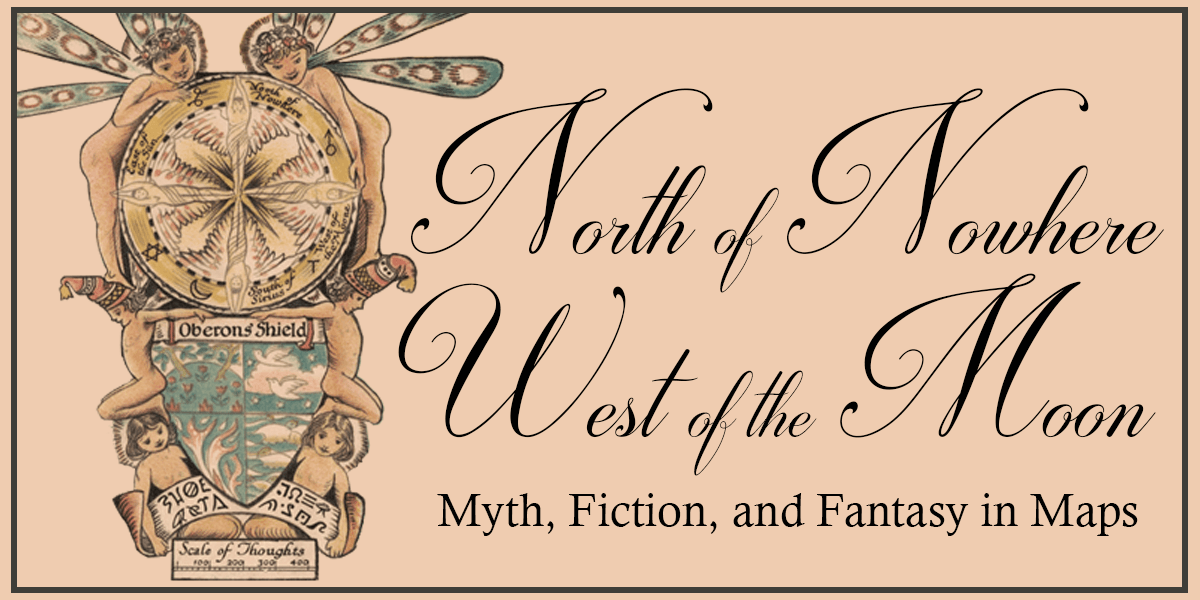

North of Nowhere, West of the Moon: Myth, Fiction, and Fantasy in Maps was conceived in late-2021 as a “pop up” exhibition (a quickly organized and timely show) to showcase a long sought after new acquisition, Bernard Sleigh’s 1918 “An Anciente Mappe of Fairyland newly discovered and set forth,” published in London (featured in the alcove immediately to your left). The title is derived from the “Fairy’s Compass” on Sleigh’s map, which indicates the cardinal directions of Fairyland as “North of Nowhere,” “East of the Sun,” “South of Sirius” and “West of the Moon,” with the scale measured in “Thoughts.” Conceptualized and planned during the late-fall of 2021, in the midst of a lengthy global pandemic soon to enter into its third year, and on the heels of our recent crowd-sourced exhibition Where Will We Go From Here? Travel in the Age of COVID-19, this fantasy map exhibition is consciously designed as an escape for viewers. It is an invitation to visitors, both in-person and online, to leave the burdens and worries of your day-to-day life and our contemporary world at the gallery doors, and to immerse yourself in worlds of myth, fiction, and fantasy, if only for a short while.
This exhibition highlights a variety of different maps, books, and games from our collections (many newly acquired) as well as from the collections of dear friends of the Osher Map Library and Smith Center for Cartographic Education (OML): Professor Stephen Hornsby, of the University of Maine, who generously lent a set of twentieth century pictorial maps from his personal collection, and the recently retired Director of USM’s Center for Book Arts, the artist Rebecca Goodale, whose own fantasy maps of “Torrado,” an imagined island in Casco Bay (created in 1993), grace the rear walls of the gallery. While the majority of our exhibitions showcase the many historic maps in our collections, this exhibition is more contemporary, highlighting dozens of maps created during the twentieth-century, many in the pictorial style. Some of the maps featured here are decidedly the products of the eras in which they were created, and we have offered contextual explanations, particularly of problematic or stereotypical depictions, on individual labels. We were, as you will quickly notice, liberal in our definitions of myth, fiction, and fantasy; viewers will find many recognizable characters from fairytales, folklore, and children’s stories from around the globe, as well ancient myths, legends, and the more recently created fantastic worlds of comic books, video games, and graphic novels. The familiar fantasy worlds of Middle Earth and Narnia, created by J.R.R. Tolkien and C.S. Lewis, grace the walls alongside doomsday prophecies, maps of theme parks, utopias, game boards and the allegorical human heart. Far from a comprehensive thematic overview of fictional maps (cartographers, artists, and writers have mapped thousands of fantasy worlds over the centuries), the exhibition is decidedly quirky and eclectic.
Finally, this exhibition also features a selection of hand-drawn maps made by Maine 4th, 5th, and 6th grade students as part of our popular annual illustrated mapmaking contest (celebrating its sixth year in 2022). We hope the items in this exhibition will inspire a new generation of artists, writers, dreamers, and cartographers to design and illustrate alternate worlds both as an escape from our own realities, and to offer possibilities for alternate futures.
Take your time. Wander. Daydream. Explore. Embrace child-like wonder. New worlds await within.
North of Nowhere, West of the Moon: Myth, Fiction, and Fantasy in Maps
1. Introduction
2. Mapping Literature and Authors
3. Fairy Tales, Theme Parks, and Imagined Worlds
4. Middle Earth and Narnia
5. The Imagined Worlds of Comics, Graphic Novels, Video Games, Film and Television
6. Myth and Allegory
7. Children’s Books and Games
8. Mapping Alternate Perceptions of the Past, Present, and Future
9. Artist’s Maps
10. Fantasy Maps Made by Maine Elementary and Middle School Students
11. Acknowledgments